Red or white, foreign or domestic, organic or conventional, there's a wine for everybody. Choose from 31 quick and easy CHOW Tips that will help you become a wine connoisseur in no time.
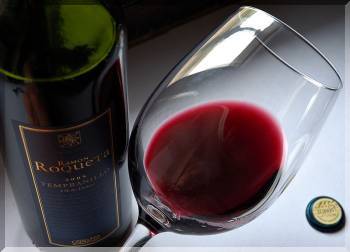
Wine
- Menu
Wine has a rich history dating back thousands of years. Today, it is the second most popular alcoholic beverage after beer.
Wine has a rich history dating back thousands of years, with the earliest known production occurring around 8,000 years ago on the territory of modern-day Georgia. It first appeared in the Balkans at about 4500 BC and was very common in ancient Greece, Thrace and Rome. Wine has also played an important role in religion throughout history. The Greek god Dionysus and the Roman equivalent Bacchus represented wine, and the drink is also used in Christian Eucharist (also called Holy Communion) ceremonies and the Jewish Kiddush.
Wine has a long history of use as an early form of medication. Today, the issue of wine and health is a topic of considerable discussion and research. However, there appears to be increasing consensus that if consumed in moderation (at most two 5-oz. servings of wine per day), wine can convey considerable health benefits, primarily because of its high concentrations of the polyphenol resveratrol. Polyphenols play a key role in the health benefits of wine by acting as antioxidants that prevent cell damage. Other beneficial compounds in wine include other antioxidants and flavonoids.
Wine is also a popular and important beverage that accompanies and enhances a wide range of European and Mediterranean-style cuisines, from the simple and traditional to the most sophisticated and complex. Wine is important in cuisine not just for its value as a beverage, but as a flavor agent, primarily in stocks and braising, since its acidity lends balance to rich savory or sweet dishes.
 Red, white, and sparkling wines are the most popular, and are known as light wines because they are only 10–14% alcohol-content by volume. Apéritif and dessert wines contain 14–20% alcohol, and are sometimes fortified to make them richer and sweeter.
Red, white, and sparkling wines are the most popular, and are known as light wines because they are only 10–14% alcohol-content by volume. Apéritif and dessert wines contain 14–20% alcohol, and are sometimes fortified to make them richer and sweeter.
Grape wine is produced by fermenting crushed grapes using various types of yeast. Yeast consumes the sugars in the grapes and converts them into alcohol. Different varieties of grapes and strains of yeasts produce different types of wine. Wine involves a long (complete) fermentation process and a long aging process (months or years) that results in an alcohol content of 9%–16% ABV. Sparkling wine can be made by adding a small amount of sugar before bottling, which causes a secondary fermentation to occur in the bottle.
Varieties of Grape Wine
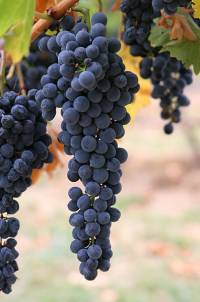 Wine is usually made from one or more varieties of the European species of Vitis vinifera, such as Pinot Noir, Chardonnay, Cabernet Sauvignon, Gamay and Merlot. When one of these varieties is used as the predominant grape (usually defined by law as a minimum of 75% or 85%), the result is a varietal, as opposed to a blended, wine. Blended wines are not necessarily considered inferior to varietal wines; some of the world's most expensive wines, from regions like Bordeaux and the Rhone Valley, are blended from different grape varieties of the same vintage.
Wine is usually made from one or more varieties of the European species of Vitis vinifera, such as Pinot Noir, Chardonnay, Cabernet Sauvignon, Gamay and Merlot. When one of these varieties is used as the predominant grape (usually defined by law as a minimum of 75% or 85%), the result is a varietal, as opposed to a blended, wine. Blended wines are not necessarily considered inferior to varietal wines; some of the world's most expensive wines, from regions like Bordeaux and the Rhone Valley, are blended from different grape varieties of the same vintage.
Wine can also be made from other species of grape or from hybrids, created by the genetic crossing of two species. Vitis labrusca (of which the Concord grape is a cultivar), Vitis aestivalis, Vitis rupestris, Vitis rotundifolia and Vitis riparia are native North American grapes usually grown to eat fresh or for grape juice, jam, or jelly, but sometimes made into wine.
Hybridization is different from grafting. Most of the world's vineyards are planted with European V. vinifera vines that have been grafted onto North American species rootstock. This is common practice because North American grape species are resistant to phylloxera, a root louse that eventually kills the vine. Grafting is done in every wine-producing country of the world except for Argentina, the Canary Islands and Chile—the only countries not yet exposed to the insect.
Classification
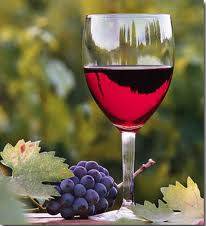 Regulations govern the classification and sale of wine in many regions of the world. The classification of wine can be done according to various methods including, but not limited to, place of origin or appellation, vinification methods and style, sweetness and vintage, or varietal used. Practices vary in different countries and regions of origin.
Regulations govern the classification and sale of wine in many regions of the world. The classification of wine can be done according to various methods including, but not limited to, place of origin or appellation, vinification methods and style, sweetness and vintage, or varietal used. Practices vary in different countries and regions of origin.
European wines tend to be classified by region (e.g. Bordeaux, Rioja and Chianti), while non-European wines are most often classified by grape (e.g. Pinot Noir and Merlot). More and more, however, market recognition of particular regions is leading to their increased prominence on non-European wine labels. Examples of non-European recognized locales include Napa Valley in California, Willamette Valley in Oregon, Columbia Valley in Washington, Barossa Valley and Hunter Valley in Australia, Central Valley in Chile, Vale dos Vinhedos in Brazil, Hawke's Bay and Marlborough in New Zealand, Okanagan Valley and Niagara Peninsula in Canada.
Wines may be classified by vinification methods. These include classifications such as red or white wine, sparkling, semi-sparkling or still, fortified and dessert wines. The color of wine is not determined by the juice of the grape, which is almost always clear, but rather by the presence or absence of the grape skin during fermentation.
Red Wine:
Red wine is made from red (or black) grapes, but its red color is bestowed by a process called maceration, whereby the skin is left in contact with the juice during fermentation.
White Wine:
White wine can be made from any color of grape as the skin is separated from the juice during fermentation. A white wine made from a very dark grape may appear pink or 'blush'. A form of Rosé is called Blanc de Noirs where the juice of red grape.
Sparkling Wine:
Sparkling wine is a wine with significant levels of carbon dioxide in it making it fizzy. The carbon dioxide may result from natural fermentation, either in a bottle, as with the méthode champenoise, in a large tank designed to withstand the pressures involved (as in the Charmat process), or as a result of carbon dioxide injection. Sparkling wine is usually white or rosé but there are many examples of red sparkling wines such as Italian Brachetto and Australian sparkling Shiraz. The sweetness of sparkling wine can range from very dry "brut" styles to sweeter "doux" varieties.
Dessert Wines:
Dessert wines range from slightly sweet (with less than 50 g/L of sugar) to incredibly sweet wines (with over 400 g/L of sugar). Late harvest wines such as Spätlese are made from grapes harvested well after they have reached maximum ripeness; they are classfied as a dessert wine. Ice Wine is made from grapes that are harvested while they are frozen. Fortified wines are often sweeter, and generally more alcoholic wines that have had their fermentation process stopped by the addition of a spirit, such as brandy, or have had additional spirit added after fermentation. Examples include Port, Madeira and Sherry.
Table Wines:
Table wines may have an alcohol content that is no higher than 14% in the U.S.. In Europe, light wine must be within 8.5% and 14% alcohol by volume. Thus, unless a wine has more than 14% alcohol, or it has bubbles, it is a table wine or a light wine. Table wines are usually classified as "white," "red," or "rosé," depending on their color. In Europe table wines are cheaper wines that often do not include the information on the grape variety used or the region of origin on the label.
Cooking Wine:
Cooking wine or Cooking sherry refers to inexpensive grape wine or rice wine (in Chinese and other East Asian cuisine). It is intended for use as an ingredient in food rather than as a beverage. Cooking wine typically available in North America is treated with salt as a preservative and food coloring. Cooking wines are convenient for cooks who use wine as an ingredient for cooking only rarely. However, they are not widely used by professional chefs, as they believe the added preservative significantly lowers the quality of the wine and subsequently the food made with that wine. Most professional chefs prefer to use inexpensive but drinkable wine for cooking.
Vintage Wine:
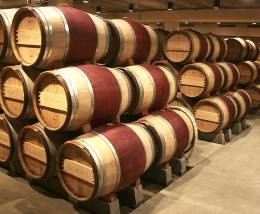 A vintage wine is one made from grapes that were all, or primarily, grown in a single specified year, and are accordingly dated as such. In certain wines, it can denote quality, as in Port wine. Variations in a wine's character from year to year can include subtle differences in color, palate, nose, body and development.
A vintage wine is one made from grapes that were all, or primarily, grown in a single specified year, and are accordingly dated as such. In certain wines, it can denote quality, as in Port wine. Variations in a wine's character from year to year can include subtle differences in color, palate, nose, body and development.
High-quality wines can improve in flavor with age if properly stored. Consequently, it is not uncommon for wine enthusiasts and traders to save bottles of an especially good vintage wine for future consumption. However, there is some disagreement and research about the significance of vintage year to wine quality. One recent study suggests that for normal drinkers, vintage year may not be as significant to perceived wine quality as currently thought, although wine connoisseurs continue to place great importance on it. Most countries allow a vintage wine to include a portion of wine that is not from the labeled vintage.
The opposite of a vintage wine is a nonvintage wine (often seen on a wine list as NV), which is usually a blend from the produce of two or more years. This is a common practice for winemakers seeking a consistent style of wine, year after year, even in bad years.
Varietal Wines:
"Varietal" describes wines made primarily from a dominant grape named grape variety, and which typically displays the name of that variety on the wine label. Examples of grape varieties commonly used in varietal wines are Cabernet Sauvignon, Chardonnay and Merlot. The wine may not be entirely of that one grape and varietal labeling laws differ. In the United States a wine needs to be composed of at least 75% of a particular grape to be labeled as a varietal wine. In the European Union, a minimum of 85% is required if the name of a single varietal is diplayed. If two or more varietals are mentioned, these varietals combined must make up 100% and they must be listed in descending order. For example, a mixture of 70% Chardonnay and 30% Viognier must be called Chardonnay-Viognier rather than Viognier-Chardonnay. Wines that display the name of two or more varieties on their label, such as a Chardonnay-Viognier, are blends and not varietal wines.
Other Wines:
Wines made from other fruits, such as apples and berries, are normally named after the fruit from which they are produced (for example, apple wine or elderberry wine) and are generically called fruit wine or country wine. Others, such as barley wine and rice wine (i.e., sake), are made from starch-based materials and resemble beer and spirit more than wine. In these cases, the term "wine" refers to the higher alcohol content rather than production process.
Serving Temperature
The temperature that a wine is served at can greatly affect the way it tastes and smells. Lower temperatures will emphasize acidity and tannins while muting the aromatics. Higher temperatures will minimize acidity and tannins while increasing the aromatics. Furthermore, wines served at warmer temperature will be more aromatic than wine served cooler due to heat's ability to increase the volatility of aromatic compounds in the wine.
Noted Master of Wine and wine writer Jancis Robinson has created a list of recommended serving temperatures for different styles of wine.
Wine Decanting
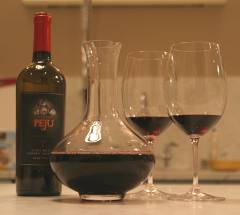 A decanter is a vessel that is used to hold the decantation of a liquid (such as wine) which may contain sediment. Decanters vary in shape and design. They are usually made of an inert material (such as glass) and will hold at least one standard bottle of wine (0.75 litre). A similar kind of vessel, the carafe, is used for serving wine as well as other drinks, but is not supplied with a stopper.
A decanter is a vessel that is used to hold the decantation of a liquid (such as wine) which may contain sediment. Decanters vary in shape and design. They are usually made of an inert material (such as glass) and will hold at least one standard bottle of wine (0.75 litre). A similar kind of vessel, the carafe, is used for serving wine as well as other drinks, but is not supplied with a stopper.
Decanters have been used for serving wines that are laden with sediments in the original bottle. These sediments could be the result of a very old wine or one that was not filtered or clarified during the winemaking process. In most modern winemaking, the need to decant for this purpose has been significantly reduced, because many wines no longer produce a significant amount of sediment as they age.
Another reason for decanting wine is to aerate it, or allow it to "breathe". The decanter is meant to mimic the effects of swirling the wine glass to stimulate the movement of molecules in the wine to trigger the release of more aroma compounds. In addition it is thought to benefit the wine by smoothing some of the harsher aspects of the wine (like tannins or potential wine faults like mercaptans). Many wine writers, such as author Karen MacNeil in the book The Wine Bible, advocate decanting for the purposes of aeration, especially with very tannic wines like Barolo, Bordeaux, Cabernet Sauvignon, Port, and Rhône wines while noting that decanting could be harmful for more delicate wines like Chianti and Pinot Noir.
However, the effectiveness of decanting is a topic of debate, with some wine experts like, oenologist Émile Peynaud, claiming that the prolonged exposure to oxygen actually diffuses and dissipates more aroma compounds than it stimulates, in contrast to the effects of the smaller scale exposure and immediate release that swirling the wine in a drinker's glass has. In addition, it has been reported that the process of decanting over a period of a few hours does not have the effect of softening tannins. The softening of tannins occurs during the winemaking and oak aging when tannins go through a process of polymerization that can last days or weeks–decanting merely alters the perception of sulfites and other chemical compounds in the wine through oxidation, which can give some drinkers the sense of softer tannins in the wine.
Wine Glasses
A wine glass is a type of glass stemware that is used to drink and taste wine. It is generally composed of three parts: the bowl, stem, and foot. Selection of a particular wine glass for a wine style is important, as the glass shape can influence its perception.
The traditionally held-to-be proper way to drink from a wine glass, especially when drinking white or otherwise chilled wine, is to grasp it by the stem. The most commonly accepted reasoning for this is to avoid fingerprints on the bowl, and to prevent the temperature of the wine from being affected by body heat.
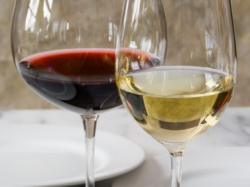 High quality wine glasses are often made of lead crystal. Lead crystal glasses have a higher index of refraction, thus changing the effect of light passing through them. Lead crystal is also rougher than glass on a microscopic level, allowing wine in the glass to breathe more efficiently when swirled in the bowl. Wine glasses are generally not colored or frosted as this would impede the appreciation of its color.
High quality wine glasses are often made of lead crystal. Lead crystal glasses have a higher index of refraction, thus changing the effect of light passing through them. Lead crystal is also rougher than glass on a microscopic level, allowing wine in the glass to breathe more efficiently when swirled in the bowl. Wine glasses are generally not colored or frosted as this would impede the appreciation of its color.
The effect of glass shape on the taste of wine has not been demonstrated by any scientific study and remains controversial. It is, however, believed by some that the shape of the glass is important, as it concentrates the flavor and aroma (or bouquet) to emphasize the varietal's characteristic. One common belief is that the shape of the glass directs the wine itself into the best area of the mouth from the varietal. Generally, the opening of the glass is not wider than the widest part of the bowl.
Most wine glasses have stems. Most common wine glasses can be divided into three types: red wine glasses, white wine glasses, and champagne flutes. Wine tumblers (without stems) are also increasing in popularity. A sherry glass is generally used for serving aromatic alcoholic beverages, such as sherry, port, aperitifs, and liqueurs, and layered shooters.
Wine Tasting
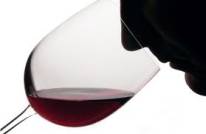 Wine tasting is the sensory examination and evaluation of wine. While the practice of wine tasting is as ancient as its production, a more formalized methodology has slowly become established from the 14th century onwards. Modern, professional wine tasters (such as sommeliers or buyers for retailers) use a constantly evolving formal terminology which is used to describe the range of perceived flavors, aromas and general characteristics of a wine. More informal, recreational tasting may use similar terminology, usually involving a much less analytical process for a more general, personal appreciation.
Wine tasting is the sensory examination and evaluation of wine. While the practice of wine tasting is as ancient as its production, a more formalized methodology has slowly become established from the 14th century onwards. Modern, professional wine tasters (such as sommeliers or buyers for retailers) use a constantly evolving formal terminology which is used to describe the range of perceived flavors, aromas and general characteristics of a wine. More informal, recreational tasting may use similar terminology, usually involving a much less analytical process for a more general, personal appreciation.
A growing number of wine schools can be found, offering wine tasting classes to the public. These programs often help a wine taster hone and develop their abilities in a controlled setting. Some also offer professional training for sommeliers and winemakers. Traveling to wine regions is another way of increasing skill in tasting. Many wine producers in wine regions all over the world offer tastings of their wine.
There are five basic stepsin tasting wine: color, swirl, smell, taste, and savor. These are also known as the "five 5" steps: see, swirl, sniff, sip, savor. During this process, a taster must look for clarity, varietal character, integration, expressiveness, complexity, and connectedness.
A wine's color is better judged by putting it against a white background. Colors can give the taster clues to the grape variety, and whether the wine was aged in wood. Heavy wines generally have a deeper color. The color is an element in the classification of wines. Main colors of wine are:
- Red
- White (light colored wine)
- Rosé (pinkish in color)
- Yellow (or straw color), see for instance vin jaune, a special and characteristic type of white wine made in the Jura wine region in eastern France, Jurançon or Sauternes
- Orange wine, a white wine that has spent some time in contact with its skin, giving it a slightly darker hue
- Burgundy (color), a shade of purplish red
- Sangria (color), a color that resembles Sangría wine
- Ox blood, a dark brownish-red color
Varietal character describes how much a wine presents its inherent grape aromas. A wine taster also looks for integration, which is a state in which none of the components of the wine (acid, tannin, alcohol, etc.) is out of balance with the other components. When a wine is well balanced, the wine is said to have achieved a harmonious fusion. Expressiveness is the quality the "wine possesses when its aromas and flavors are well-defined and clearly projected. The complexity of the wine is affected by many factors, one of which may be the multiplicity of its flavors. The connectedness of the wine, a rather abstract and difficult to ascertain quality, describes the bond between the wine and its land of origin (terroir).
To ensure impartial judgment of a wine, it should be served blind—that is, without the taster(s) having seen the label or bottle shape. Blind tasting may also involve serving the wine from a black wine glass to mask the color of the wine. A taster's judgment can be prejudiced by knowing details of a wine, such as geographic origin, price, reputation, color, or other considerations.
Aromas of Wine:
Within wine there are volatile and non-volatile compounds that contribute to the make up of a wine's aroma. During the fermentation and for the first few months of a wine's existence, chemical reactions among these compounds occur frequently and a wine's aroma will change more rapidly during this period than at any other point. As a wine ages and matures, changes and developments in aroma will continue to take place but at a slower and more gradual pace.
It is through the aromas of wine that wine is actually tasted. When wine is sipped, it is warmed in the mouth and mixes with saliva to vaporize the volatile aroma compounds. These compounds are then inhaled "retro-nasally" through the back of the mouth to where it is received by nearly five million nerve cells. The human tongue is limited to the primary tastes perceived by taste receptors on the tongue—acidity, bitterness, saltiness, sweetness and umami. The wide array of fruit, earthy, floral, herbal, mineral and woodsy flavor perceived in wine are derived from aroma notes interpreted by the olfactory bulb.
In wine tasting, wine is often smelled before being drunk in order to identify some components of the wine that may be present. Different terms are used to describe what is being smelled. The most basic term is aroma which generally refers to a "pleasant" smell as opposed to odor which refers to an unpleasant smell or possible wine fault. The term aroma maybe further distinguished from bouquet which generally refers to the smells that arise from the chemical reactions of fermentation and aging of the wine. In professional wine tasting, there is generally a distinction made between "aromas" and a wine's "bouquet" while in casual wine tasting these two terms are used interchangeably.
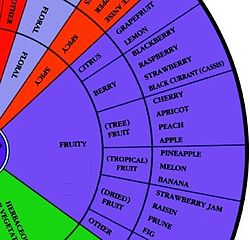 Wines served at warmer temperature will be more aromatic than wine served cooler due to heat's ability to increase the volatility of aromatic compounds in the wine. Swirling, or aerating, the wine will introduce more air molecules into the wine which can capture the aroma molecules and carry them up to the nose. Some subtle aromatics can be overwhelmed by more dominant aromatics that arise after swirling, so most professional tasters will sniff the wine briefly first before swirling. The closer the nose is to the wine, even right inside the glass, the greater chances of aromatics being captured. A series of short, quick sniffs versus one long inhale will also maximize the likelihood of aromatics being detected. The human nose starts to "fatigue" after around six seconds and so a pause may be needed between sniffs.
Wines served at warmer temperature will be more aromatic than wine served cooler due to heat's ability to increase the volatility of aromatic compounds in the wine. Swirling, or aerating, the wine will introduce more air molecules into the wine which can capture the aroma molecules and carry them up to the nose. Some subtle aromatics can be overwhelmed by more dominant aromatics that arise after swirling, so most professional tasters will sniff the wine briefly first before swirling. The closer the nose is to the wine, even right inside the glass, the greater chances of aromatics being captured. A series of short, quick sniffs versus one long inhale will also maximize the likelihood of aromatics being detected. The human nose starts to "fatigue" after around six seconds and so a pause may be needed between sniffs.
Ann C. Noble is a sensory chemist and retired professor from the University of California, Davis invented the Wine Aroma Wheel which is credited with enhancing the public understanding of wine tasting and terminology. The Wine Aroma Wheel provides a visual graphic of the different categories and aroma components that one can encounter in wine. The terminology used is standardized for use by both professionals and amateur wine tasters. The wheel breaks down wine aromas into 12 basic categories and then further sub-divided into different aromas that can fall into those main categories.
You can learn more about the Wine Aroma Wheel and buy one at: WineAromaWheel.com
Study of the compounds responsible for aroma and flavor, as well as their correlation with a wine's quality, is ongoing. As understanding of these compounds grows, there is concern that wines in the future could be "manipulated" through the use of chemical additives to add complexity and additional aromas to wine (such as creating a manufactured perfume).
Wine Tasting Descriptors:
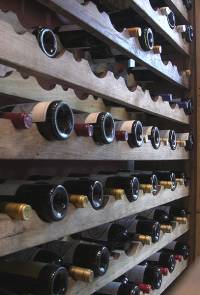 The use of wine tasting descriptors allows the taster an opportunity to put into words the aromas and flavors that they experience and can be used in assessing the overall quality of wine. Many wine writers, like Karen MacNeil in her book The Wine Bible, note that the difference between casual drinkers and serious wine tasters is the focus and systematic approach to tasting wine with an objective description of what they are sensing. The primary source of a person's ability to taste wine is derived from their olfactory senses. A taster's own personal experiences play a significant role in conceptualizing what they are tasting and attaching a description to that perception. The individual nature of tasting means that descriptors may be perceived differently among various tasters.
The use of wine tasting descriptors allows the taster an opportunity to put into words the aromas and flavors that they experience and can be used in assessing the overall quality of wine. Many wine writers, like Karen MacNeil in her book The Wine Bible, note that the difference between casual drinkers and serious wine tasters is the focus and systematic approach to tasting wine with an objective description of what they are sensing. The primary source of a person's ability to taste wine is derived from their olfactory senses. A taster's own personal experiences play a significant role in conceptualizing what they are tasting and attaching a description to that perception. The individual nature of tasting means that descriptors may be perceived differently among various tasters.
Click here for a general list of wine tasting descriptors. Click here for a brief summary of typical descriptors for the better-known wine grape varieties (varietals).
The sweetness of wine is determined by the amount of residual sugar in the wine after fermentation. How sweet a wine will taste is also controlled by factors such as the acidity and alcohol levels, the amount of tannin present, and whether the wine is sparkling or not. Dry wine, for example, has only a small amount of residual sugar, thus lacks the perception of sweetness. However, a dry wine can taste sweet if the alcohol level is elevated. Similarly, sweet wine has a noticeably high level of residual. However, a sweet wine, such as a Vouvray, can actually taste dry due to the high level of acidity. Medium and sweet wines have a perception among many consumers of being of lower quality than dry wines. However, many of the world's great wines, such as those from Sauternes (including Barsac) or Tokaj, have a high level of residual sugar, which is carefully balanced with additional acidity to produce a harmonious result.
Wine and Food Pairing:
Wine and food matching is the process of pairing food dishes with wine to enhance the dining experience. In many cultures, wine has had a long history of being a staple at the dinner table and in some ways both the winemaking and culinary traditions of a region will have evolved together over the years. Rather than following a set of rules, local cuisines were paired simply with local wines.
The modern "art" of food pairings is a relatively recent phenomenon, fostering an industry of books and media with guidelines for pairings of particular foods and wine. In the restaurant industry, sommeliers are often present to make food pairing recommendations for the guest. The main concept behind pairings is that certain elements (such as texture and flavor) in both food and wine react differently to each other and finding the right combination of these elements will make the entire dining experience more enjoyable. However, taste and enjoyment are very subjective and what may be a "textbook perfect" pairing for one taster could be less enjoyable to another.
While there are many books, magazines and websites with detailed guidelines on how to pair food and wine, most food and wine experts believe that the most basic element of food and wine pairing is understanding the balance between the "weight" of the food and the weight (or body) of the wine. Heavy, robust wines like Cabernet Sauvignon can overwhelm light delicate dish like a quiche while light bodied wines like Pinot grigio would be similarly overwhelmed by a hearty stew. Beyond weight, flavors and textures can either be contrasted or complemented. From there a food and wine pairing can also take into consideration the sugar, acid, alcohol and tannins of the wine and how they can be accentuated or minimized when paired with certain types of food.
CHOW Tips:
 |
BEER: 3 ways to chill beer, how to pair beer with food, how to identify off flavors in beer, and more. |
 |
SPIRITS: How to taste fine spirits, when to blow on your liquor, how to make the perfect martini and more. |
 |
MEAT & POULTRY: How to choose fresh meat, how to grill, how to make the perfect hamburger, and more. |
 |
SEAFOOD: 22 back-of-the-house secrets from chefs, such as how to buy fresh fish, and how to smoke or grill seafood. |
 |
PRODUCE: Tips that will help you get your daily recommended servings of grains, cereals, fruits, and vegetables. |
 |
CHEESE: How to buy cheese, how to cut and serve cheese, whether or not to freeze cheese, and more. |
 |
COFFEE: Banish bitter coffee from your repertoire. CHOW Tips will help brew a delicious cup every time. |
Contact Us | Shop | Sitemap | Join Our Team | Investors | Advertise | Web Design Services
Community | Foodies' Choice | Meetup Groups | Chat | Blogs | Forums | Submit Your Site | Resources






